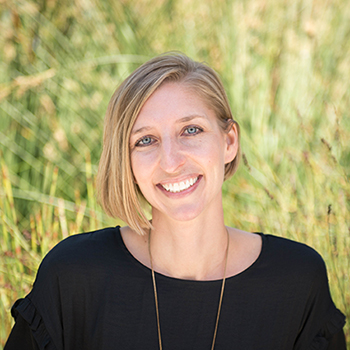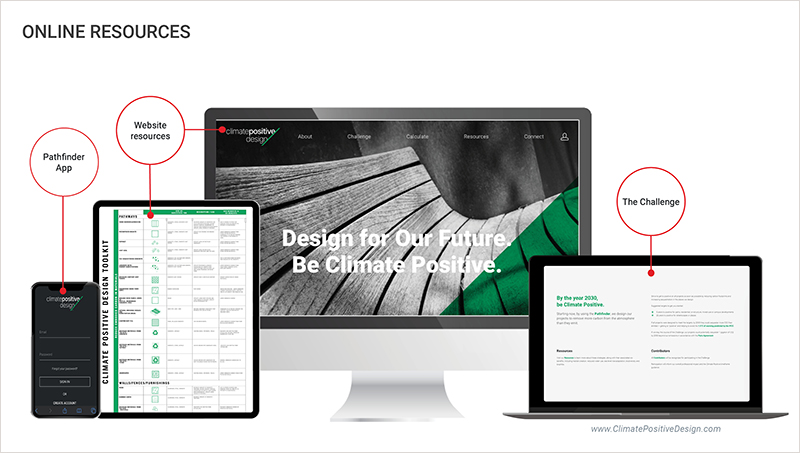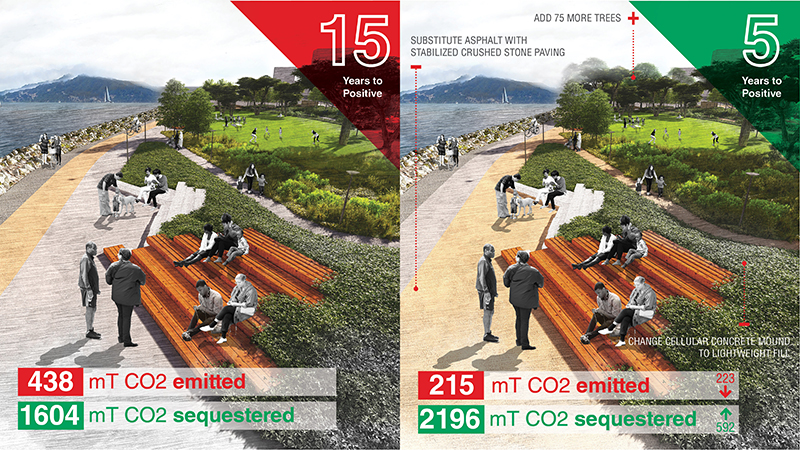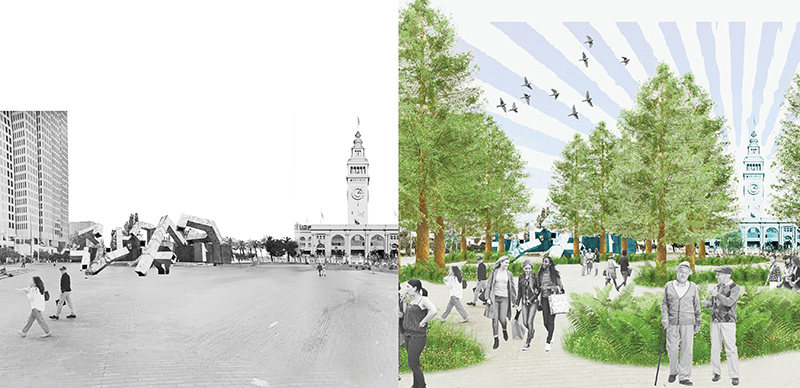News
Interview with Pamela Conrad
 Pamela Conrad, ASLA
Pamela Conrad, ASLA
A year ago, you launched Climate Positive Design in an effort to help landscape architects design and build projects that can become climate positive, meaning that over their lifespan they sequester more greenhouse gas emissions than they embody or produce. You also put out a major challenge to the community, stating that if all landscape architects and designers took a climate positive approach, they could sequester an estimated one gigaton of greenhouse gases by 2050. What motivated you to start this effort?
First, I had to dig in and understand all the science and policy. I made a conscious effort to understand the Paris Climate Accord, and more recently, the Intergovernmental Panel on Climate Change (IPCC) report calling for limiting global temperature increase to 1.5 °C (2.7 ˚F).
I was shocked to find out that according to the IPCC, we have less than ten years to prevent catastrophic events from happening to human lives, and that those who have the least, particularly in the global South, will likely be impacted the most.
A few years back, I read the book Drawdown: The Most Comprehensive Plan Ever Proposed to Reverse Global Warming. It was the first time climate solutions were broken down and made accessible. I realized that 20 percent of the outlined solutions are land-based and can be part of landscape architects' everyday work.
Out of curiosity, I began analyzing case study projects from our work at CMG. I realized it is relatively easy to improve the carbon impacts of our projects without reducing the quality or performance.
I started to grasp that what we do as designers can make a big difference when we scale up all of our work around the world. It was with this understanding that I launched the Climate Positive Design Challenge.
 Climate Positive Design
Climate Positive Design Since launching the Pathfinder app, a tool that helps landscape architects, developers, and property owners design to a carbon positive state, nearly 1,500 projects have been submitted, totaling more than 43,000 acres. In addition to other climate-friendly practices, these projects are expected to plant 777,000 trees, which, in ten years, will result in 1.6 million metric tons of greenhouse gases being sequestered. What have you learned from this first set of projects? What patterns are you seeing?
Within the first year, we've seen a gradual improvement in the years-to-positive scores across project sites. This is being achieved by a continuous reduction in greenhouse gas emissions through the embodied carbon and materials and operational carbon in landscapes, and an increase of carbon sequestration. It’s looking at that overall equation for a landscape carbon impact.
In the first few months, we saw a lot of academic projects being logged. It seems that the Pathfinder is being widely used as a teaching tool, which is great! Since realizing that, we've added in a feature, so those studies can be used as an academic resource, but their data will be excluded from the overall impact numbers.
The current average years-to-positive is 21 years for urban landscapes like plazas and streetscapes, and the target is 20 years to positive, so we're really close to reaching our goal. We will perhaps make it more challenging going forward.
For parks and gardens, campuses -- inherently greener projects – the years to positive target is five years. The average of all the projects received to date is nine years to positive, so we’re not quite there yet. We need to keep pushing, which is the point of a challenge.
 Climate Positive Design
Climate Positive Design
We've also seen that the projects across the board have over three times more sequestration than emissions, which is fantastic. This would put us on track to meeting our overall goals.
One of the helpful things about the data we have collected over this past year is that we can see the average emissions and sequestration per square foot. That information will be used in the upcoming landscape carbon SITES and LEED pilot credits. We're now able to take this data, transform it, and relate it to other rating systems, which will hopefully increase exposure and awareness of Climate Positive Design and other rating systems.
What are the top five things all landscape architects should be doing now in their projects to sequester more carbon and get to climate positive? What things have the biggest bang for the buck, in terms of the climate?
I like to keep things simple. Otherwise, it’s too easy to become overwhelmed and not change our practices.
The top five things to remember are: plant more; pave less; use materials with lower embodied carbon; update your specifications to meet the highest sustainability performance standards, specifically your concrete specifications by using cement substitutions. The fifth is to create operations and maintenance manuals that limit the use of fossil fuels to operate the equipment to maintain landscapes -- so use organic fertilizers rather than fertilizers made from fossil fuels.
You note that deciduous trees store a bit more carbon than evergreens. Are there particular species of trees and shrubs that are carbon sequestering powerhouses?
This is perhaps the most frequently asked question. There is no one perfect tree for sequestering the most carbon. The best tree to plant is the one that will grow the fastest, live the longest, and get the biggest. This the tree that is going to sequester the most carbon in the region your project is located.
Carbon is directly correlated to biomass. A redwood tree -- a massive tree that lives a very long time -- is going to sequester much more carbon than a small, understory redbud tree. This is just as an example where size does matter.
Another interesting example is bamboo. It is a rapidly renewable, woody species that can be converted into building products, such as flooring, furniture, even structures. It's incredibly strong and actually a grass, so the carbon within its root system can stay in the soil for thousands of years. It is a super sequesterer, but it should be used with caution, because it can be an invasive species.
How can we ensure that plants selected to store carbon also support local ecosystems and provide habitat for pollinators and wildlife?
Bamboo demonstrates how we need to be mindful that we don’t cause more problems than we had before. We must be mindful of not planting invasive species that will take over native plant communities and reduce biodiversity.
I would recommend anyone to refer to the International Union for Conservation of Nature (IUCN) global standard for nature-based solutions, which outlines ecosystem-based approaches that are specific to geographic locations and address societal changes, supporting human well-being, and include biodiversity benefits.
We can use native species to sequester more carbon where they're appropriate, increasing biodiversity and reducing water usage at the same time. Native plants are one way to ensure we support local ecosystems.
How can landscapes architects partnering with historically-marginalized and underserved communities, which experience higher climate risks and impacts, use your tool to address climate injustices?
This is one of our biggest challenges to overcome as a profession. I do not have all the answers.
But I will say that from my experience, really listening to people and meeting them where they are is a start. If people say what they really need most are jobs, then don’t give them a skate park. Think about how we can partner in non-traditional ways to create jobs that might also improve quality of life and be part of climate solutions – like community jobs programs supporting tree-planting initiatives.
The results of something like this can be measured in local school programs through the app for free. It’s my hope that things like this can give the next generation hope that there are solutions out there. We just need to work together on them.
What models or innovations that aren't widespread today could speed up the carbon sequestering abilities of plazas and streets with large areas of hardscape?
There are definitely innovative products coming out that capture carbon, such as Carbon Cure. But I challenge us not to rely wholly on new models or fancy innovations, and instead step back and think about simplifying things.
This is an opportunity for us to rethink how we design, to do more with less. Let's rethink the typical plaza. Maybe it doesn't have to be all concrete. Maybe it can have large trees in a field of stabilized, crushed stone paving, as many historic plazas around the world.
 San Francisco Ferry Building Plaza design proposal / CMG Landscape Architecture
San Francisco Ferry Building Plaza design proposal / CMG Landscape Architecture
This is my challenge to the profession: let's think about things differently. Let's turn this into an opportunity to make a statement that we believe in climate-positive landscapes. We're taking a stance on climate change, and that's something that many of our clients will get behind.
What needs to happen in the landscape architecture product marketplace to further accelerate climate positive design? How are you seeing product manufacturers respond to the climate crisis?
Over the past decade, in other disciplines, architecture in particular, product manufacturers have been increasing the transparency of their material and product development processes and revealing associated emissions. Product manufacturers are providing this information through an environmental product declaration (EPD). The data manufacturers provide -- the CO2e emissions related to Global Warming Potential (GWP) -- is what is used in the Pathfinder calculations.
We hope this increased transparency in the architecture field will migrate to the landscape products space. We must ask landscape product manufacturers to provide EPDs so we can make informed decisions about which product or material to choose.
Vestre, a Norwegian landscape product manufacturer, is currently working with Climate Positive Design to include their products into the app. They're going to be providing their EPDs for use in the Pathfinder. They do not want us be exclusive, but rather encourage other product manufacturers to provide the same level of transparency and include their products as well, which says a lot about their values.
 Vestre
Vestre
I hope that everyone will jump onboard, because this is an opportunity at a global scale to reduce the impact of these products.
The latest version of your app, Pathfinder 2.0, includes a bunch of new features. What improvements were made? And what do you hope to tackle next?
New features include the ability to compare design alternatives; analyze existing conditions; and understand site impacts, like grading, tree removal, or reused soil imports and amendments. There is also improved data that covers the replacement of materials over time, and more data transparency in the way of pop-ups and information icons.
As I mentioned, we'll be adding products into the app soon. But we're also hoping to expand the sequestration data for ecosystem restoration projects. Forest restoration is coming up next. Then, we’re hoping to get financial support, in the form of donations, to expand to coastal wetlands, kelp, mangroves, grasslands, etc.
The goal remains to keep the app free, open, and accessible for all to use and make a difference in projects. This is a commitment I have made. I believe there is an incredible opportunity for landscape architects to re-imagine landscapes so they are not only wonderful places for people, but also help solve the climate crisis.
Pamela Conrad, ASLA, is a principal at CMG Landscape Architecture in San Francisco, California, and founder of Climate Positive Design. She is a recipient of the 2018 Landscape Architecture Foundation Fellowship for the development of the award-winning Pathfinder landscape carbon calculator app and the Climate Positive Design Challenge.